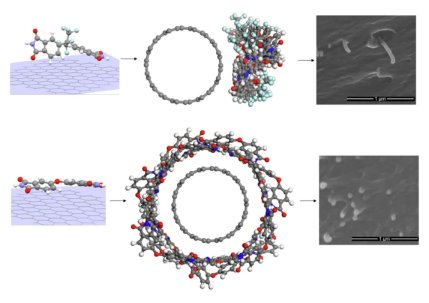Publications
Select the year of publication...
| 2016-2018 | 2019-2021 | 2022-2024 | 2025 |
| 2004-2006 | 2007-2009 | 2010-2012 | 2013-2015 |
| before 1990 | 1991-1995 | 1996-2000 | 2001-2003 |
...or go to the
Recent Publications
The size of critical secondary nuclei of polymer crystals does not depend on supersaturation
Yang Liu, Zhiqi Wang, Yao Zhang, Tianyu Wu, Tianze Zheng, Bao Hua Guo, Günter Reiter, Jun Xu. Nature Communications 16 (2025) 3773
It is still a great challenge to determine the size of critical nuclei, which is crucial for a comprehensive understanding of crystallization and for testing the controversial crystallization theories. Here, we propose a method to determine the size of critical secondary nuclei on growth faces of poly(butylene succinate) single crystals in solution, basing on the probability of statistically selecting crystallizable units in random copolymers. In a dilute solution and for a given crystallization temperature, we reveal that the size of critical secondary nuclei was independent of supersaturation, contrary to the well-accepted prediction of existing theories which expect that the size of the critical nucleus increases with decreasing supersaturation. Accounting correctly for the dilution-caused change in the steady-state concentration of clusters of various sizes, we remedy inconsistencies of existing theoretical approaches in deriving the correct size of critical secondary nuclei in solution being independent of supersaturation. (more...)
Binghua Wang, Hailong Zou, Xuchen Wang, Changyu Shen, Jingbo Chen, Günter Reiter, Bin Zhang. Nature Communications 16 (2025) 3275
The dissolution of polymer crystals often proceeds at rates varying in time and space. Here, using low molecular weight poly(ethylene oxide) as a model polymer, we exploit step-wise selective dissolution for unveiling how spatial variations in metastability are generated during the growth of lamellar polymer single crystals. The dissolution velocity along defined crystal faces is constant, but ca. 5 times faster for rough than for smooth faces. From the temperature dependence of dissolution, we derive detachment energies of 420 ± 40 kJ/mol and 650 ± 50 kJ/mol for rough and smooth faces, respectively, suggesting that on a rough face polymer chains have ca. 1/3 less neighboring molecules to interact with. The observed high values of the activation energy indicate that, for dissolving a polymer crystal, the progressive detachment of whole chains is indispensable. Our study reveals a strong relation between growth kinetics and the resulting metastability of polymer crystals. (more...)
Baode Zhang, Snežana D. Zarić, Sonja S. Zrilić, Iosif Gofman, Barbara Heck, Günter Reiter. Communications Chemistry 8 (2025) 21
 The interplay between attractive London dispersion forces and steric effects due to repulsive forces resulting from the Pauli principle often determines the geometry and stability of nanostructures. Aromatic polyimides (PI) and carbon nanotubes (CNT) were chosen as building blocks as two components in the hetero delocalized electron nanostructures. Two PIs, having the same diamine part and different linkage substituents between two phenyl rings of dianhydride part, one linked with ether bond (C-O-C) (OPI), the other with C-(CF3)2 (FPI), were investigated. Surprisingly, two CNT/PI nanocomposites show distinct failure mode from CNT yielding to CNT pull-out failure. Calculation of the interaction energy and chain conformations of each PI upon CNT was performed by accurate density functional theory (DFT) calculations and molecular dynamic simulation (MDS). (more...)
The interplay between attractive London dispersion forces and steric effects due to repulsive forces resulting from the Pauli principle often determines the geometry and stability of nanostructures. Aromatic polyimides (PI) and carbon nanotubes (CNT) were chosen as building blocks as two components in the hetero delocalized electron nanostructures. Two PIs, having the same diamine part and different linkage substituents between two phenyl rings of dianhydride part, one linked with ether bond (C-O-C) (OPI), the other with C-(CF3)2 (FPI), were investigated. Surprisingly, two CNT/PI nanocomposites show distinct failure mode from CNT yielding to CNT pull-out failure. Calculation of the interaction energy and chain conformations of each PI upon CNT was performed by accurate density functional theory (DFT) calculations and molecular dynamic simulation (MDS). (more...)
Valentina Pirela, Leire Unanue, Justine Elgoyhen, Javier Ramos, Juan Francisco Vega, Agurtzane Mugica, Manuela Zubitur, Cuong Minh Quoc Le, Abraham Chemtob, Radmila Tomovska, Günter Reiter, Jaime Martín, Alejandro J. Müller. European Polymer Journal (2025) 113721
This work studies how the chemical structure of relatively similar high-sulfur alternating polythioether homopolymers (DMDS-alt-DVE, DMDS-alt-TEGDVE, and DMDS-alt-BDDVE) affects their structural properties, morphology, polymorphism, and crystallization kinetics. Differential scanning calorimetry (DSC) and polarized light optical microscopy (PLOM) experiments revealed a complex crystallization for the samples in which up to three different polymorphic phases were identified: a very low melting crystal form (VL-Tm form), a low melting crystal form (L-Tm form) and a high melting crystal form (H-Tm form), characterized by their corresponding melting temperature ranges and confirmed via Wide-Angle X-ray Scattering (WAXS). A coexistence of negative and positive spherulites was found, and their origin was revealed by atomic force microscopy (AFM), which showed how the lamellar arrangement varied in the samples from predominantly radial to a cross-hatched morphology. (more...)
List of Publications
- Determination of Lamellar Structure of Partially Crystalline Polymers by Direct Analysis of their Small-Angle X-Ray-Scattering Curves
- G.R. Strobl. Journal of Applied Crystallography 6, 365-370 (1973)
- Synthese und Eigenschaften molekulareinheitlicher n-Paraffine bis zum C140H282
- W. Heitz, E.W. Fischer, R. Peters, T. Wirth, G. Strobl. Makromolekulare Chemie 162, 63 (1972)
- Analyse von spaltverschmierten Kleinwinkelstreukurven lamellarer Strukturen
- G.R. Strobl. Kolloid-Zeitschrift and Zeitschrift für Polymere 250, 1039-1046 (1972)
- A New Method for Evaluating Slit-Smeared Small Angle X-Ray Scattering Data
- G.R. Strobl. Acta Crystallographica A 26, 367-375 (1970)


